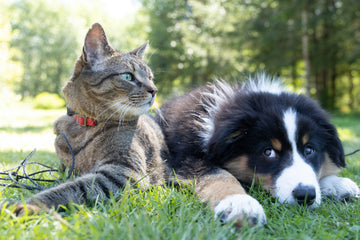When we hear the word allergies, many of us picture springtime sneezing fits, red noses, or hastily reading ingredient labels. But allergies aren’t just a human headache — our pets can be just as sensitive, even if they can't tell us directly. If you’ve ever seen your dog gnawing at its paws or your cat scratching more than usual, allergies might be the silent culprit.
Just like us, pets have immune systems that sometimes get a little too overprotective. And when that happens, their bodies treat harmless things — like pollen or chicken — as dangerous intruders.
🌿 What Exactly Are Pet Allergies?
At their core, allergies are the immune system’s overreaction to something that shouldn’t be a threat. In pets, the list of possible allergens is surprisingly long: pollen, mold spores, certain foods, flea bites, cleaning products, and even fabrics.
The trickiest part? Many symptoms mimic other issues — so it takes a bit of detective work (and often a vet’s help) to get to the root.
🌼 Common Types of Allergies in Pets
1. Environmental Allergies (aka Atopy)
Does your pup scratch endlessly after rolling in the grass? Or does your cat’s skin flare up in spring? Environmental allergens — like pollen, mold, dust mites, or even another pet’s dander — can stir up year-round or seasonal issues.
Look for:
-
Itchy skin
-
Ear infections
-
Red, irritated paws (often from obsessive licking)
🌟 Tip: After outdoor walks, gently brushing off pollen and dust with a soft grooming tool like the Bobopal Steam Brush can help minimize skin irritation and keep allergens off your pet’s coat.
2. Food Allergies
Some pets are picky eaters; others are allergic to what’s in their bowl. Unlike food intolerances (which usually cause stomach troubles), true food allergies often show up on the skin or in the ears.
Common triggers:
-
Proteins (chicken, beef, fish)
-
Dairy
-
Eggs
-
Grains (though rarer)
-
Artificial additives
Symptoms might include:
-
Itchy skin
-
Chronic ear infections
-
Upset stomach
3. Flea Allergy Dermatitis (FAD)
Imagine being so allergic to flea saliva that one bite sends your pet into a scratching frenzy. That’s FAD — and it’s more common than you’d think.
Signs include:
-
Hair loss around the tail
-
Intense itching
-
Hot spots or sores
💡 Prevention is key — keeping up with flea treatments year-round is one of the easiest ways to avoid this misery.
4. Contact Allergies
Sometimes, it’s not what your pet eats or breathes — it’s what they touch. Fabrics, shampoos, floor cleaners, and lawn chemicals can all trigger reactions.
Watch for:
-
Red or bumpy skin
-
Irritation around areas that touch surfaces, like paws or belly
🐾 Bonus tip: If your pet’s skin is sensitive, brushing with a natural, gentle tool like the Bobopal Wooden Dog Comb can help soothe irritation without adding to the problem.
5. Insect Bites & Stings
Beyond fleas, your pet might also react to mosquitoes, bees, ticks, or wasps. Most reactions are minor — but some can become serious very quickly.
👀 What Do Pet Allergy Symptoms Look Like?
Not all sneezes are created equal — in fact, most allergic pets don’t sneeze at all. Instead, allergies often show up as:
-
Constant scratching or licking
-
Ear infections or smelly ears
-
Vomiting or diarrhea (especially with food allergies)
-
Bald patches or red, inflamed skin
-
Swelling around the face or eyes
-
Chewing on paws
🔍 How Allergies Are Diagnosed in Pets
Vets typically rely on a mix of observation, elimination, and testing:
-
Physical exams to spot patterns
-
Elimination diets to uncover food triggers
-
Blood or skin tests for environmental allergens
-
Flea combing and inspection (often overlooked but crucial)
🩺 Managing and Treating Pet Allergies
There’s no one-size-fits-all cure, but most allergies can be managed with the right approach:
-
Medications: Antihistamines or steroids to ease inflammation
-
Flea control: Topical treatments, collars, and shampoos
-
Diet changes: Hypoallergenic or limited-ingredient diets
-
Allergy shots: Gradually build your pet’s resistance
-
Baths and wipes: Medicated or hypoallergenic products help wash allergens off
🪥 Pro tip: If your pet’s skin or oral health is affected by allergies, introducing gentle tools like the Bobopal Dog Toothbrush can help reduce bacterial buildup and support comfort from the inside out.
🛡️ Can You Prevent Allergies in Pets?
You may not be able to eliminate every allergen, but small steps go a long way:
-
Vacuum often and wash pet bedding regularly
-
Choose gentle, fragrance-free grooming products
-
Introduce new foods slowly
-
Stay on top of flea prevention
-
Wipe your pet’s paws and coat after time outdoors
🚨 When to Call the Vet
If you notice severe or sudden symptoms, don’t wait:
-
Swelling of the face or throat
-
Trouble breathing
-
Repeated vomiting or diarrhea
-
Collapse or weakness
These signs can point to a life-threatening allergic reaction and need urgent care.
💬 Final Thoughts
Yes — pets can have allergies. And while they can’t tell you what’s wrong, they sure know how to show it. With a little observation, the right tools, and some help from your vet, you can uncover the causes and help your furry companion live a far more comfortable life.
After all, they’re not just pets — they’re family. And they deserve to breathe easy, itch less, and wag more.






